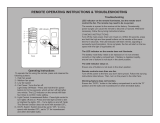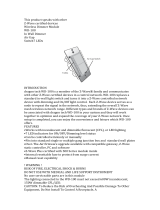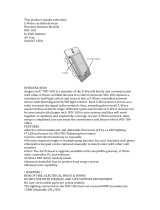
Metropolitan Wireless Keypads and Dimmers 2 of 4 Copyright © 2018 Savant Systems, LLC
009-1436-04 | 181212
Hardware Overview
Front Panel
A
Ambient Light Sensor - Detects the level of ambient light in the room and adjusts the LED brightness on the front panel. The
ambient light sensor operation is modifi ed using RacePoint Blueprint®.
B
Dimming Level - Six indicator LEDs track the brightness of the load. LEDs turn on from left to right as intensity on load
increases and turns o from right to left as intensity decreases. Once confi gured in Blueprint, the LEDs track the brightness of
the scene created.
C
RESET Button – The reset button has two functions:
– Press and Hold (hold for 5 seconds) – Resets keypad to AP Mode
– After fi ve seconds, all LEDs on the front panel illuminate, remain on for two seconds, and then fl ash twice. The keypad
reboots and reverts to Access Point Provisioning Mode (AP Mode). In this mode, the two top button LEDs blink in an
alternating pattern. The keypad is now ready to be provisioned. Refer to the Metropolitan Style Wireless Lighting –
Provisioning guide on how to provision the keypad.
– Press and Release – Calibrates keypad.
– After releasing, all LEDs illuminate for about six seconds and then fl ash twice.
– The load characteristics are checked to determine the best phase for the attached load.
– The control parameters for the no neutral operation, if applicable, are determined.
HELPFUL INFORMATION!! (For Press and Release)
– After the calibration is complete, the keypad resets and the button LEDs will blink a specifi c pattern. The pattern
indicates if the keypad was previously connected to a wireless network. Refer to the table in the Electrician Removal/
Installation section below for the states the keypad could be in after a reset.
D
Switch LED - LED lights when button is pressed. LEDs are also used to indicate the state of the switch when connecting
switch to a network. Refer to the LED Sequencing table. Once confi gured in Blueprint, the Switch LED shows the scene state.
E
Service Switch - The service switch disconnects power from the load (red wire). Toggle the service switch to O whenever
changing the load. The service switch can also be used to power cycle the dimmer.
F
Green
Ground - Wire to Gnd.
G
White
Neutral - Return path for voltage.
H
Yellow
Traveler - Wire to one or more Auxiliary Controls for multi-location control.
I
Red
Load -Wire to the load.
J
Black
Line - Wire to hot from AC power source.
WIK-xxx105 WID-xxx102
Device wires are all a fi ve inch #16 AWG stranded wire.
LEDs blink in an
alternating pattern
Keypad is in AP Mode and needs to be provisioned. After a short time (up to one minute), the
blinking will stop. In this state, the keypad is still in AP Mode. The blinking stopped intentionally
for cases where the device is not provisioned onto the network and can be used as a manual
control till provisioned.
Left Button LED: solid
Right Button LED: blinks
Keypad is connected to the local network (IP Address assigned) but not bound to the Host/
Controller. After a short time (up to one minute), the blinking will stop. Although the blinking has
stopped, the keypad remains in this state until the binding process is complete.
Both top Button LEDs
blink in sync
If the IP settings are incorrect, the keypad tries to establish a connection with the local network.
After a short time (up to one minute) the blinking will stop. Although the blinking has stopped,
the keypad remains in this state until it is reset to its default values and then provisioned with the
correct network settings.
All Dimming LEDs blink Indicates the type of load connected is not supported. Try toggling service switch to recalibrate.
LED Sequencing
UP
120V 60Hz
E
D
C
B
A
UP
120V 60Hz
A B
C
D
E
F G H I J
Rear Panel
Metropolitan Wireless Keypads and Dimmers 3 of 4 Copyright © 2018 Savant Systems, LLC
009-1436-04 | 181212
Electrician Removal/Installation
ELECTRIC SHOCK! The 120V AC, 60 Hz source power poses an electrical shock hazard that has the potential to cause serious
injury to installers and end users.
IMPORTANT NOTES!
– A licensed electrician is required to install any of the Metropolitan wireless lighting devices. Isolate and turn o power at the
main breaker panel prior to installing any electrical devices.
– For supply, neutral, and ground connections use only #14 AWG or larger solid copper wires (80°C) with insulation stripped
to ⅝ in (16 mm).
1. From the main electrical panel, switch o the breaker supplying power to the circuit.
2. Unscrew and remove the wall plate (if applicable).
3. Verify power is removed using a 120V AC tester.
4. Unscrew the two 6-32 fl at head screws and remove the existing toggle/rocker switch or analog dimmer (if applicable).
5. Disconnect wires and remove the device. It is good practice to label each wire as it is removed. If not already identifi ed, mark
each wire to ensure proper rewiring, especially if the circuit employs a 3-way confi guration.
6. Connect the in-wall wires to the leads coming from the Metropolitan style device using the supplied wire nuts or an approved
alternative. Refer to the Wiring Diagrams section for di erent diagram setups.
7. Insert the new device (dimmer, switch, keypad, etc.) into the electrical switch box and secure using the 6-32 fl at head screws
provided. DO NOT use a powered screw driver. A powered screwdriver can over tighten the screws.
8. Install the front faceplate wall plate adapter. Toggle the Service
Switch to the O position.
9. Switch power at the breaker to On and toggle the Service Switch
to power-on the keypad. The keypad will go through a diagnostic
sequence and calibrate itself to the type of load connected. The
LEDs will blink as follows
– All LEDs illuminate bright and then blink twice.
– The load will switch On for a few seconds and then switch O .
In some instances, the load may switch On again and gradually
dim up to full brightness to further refi ne the calibration
process.
– Next, the top two button LEDs blink a specifi c pattern. The
pattern indicates the state of the keypad. The patterns and
state of the keypad are described in the next table
NOTE: Install the wall adapter to cover the metal yoke prior to
applying power. If replacing a Echo style device, remove
power before removing the wall plate adapter
10. Verify the keypad is calibrated and working correctly, press the rotary dial and the load connected to the red wire will switch On.
Turn the dial clockwise to increase the brightness of the load and turn counterclockwise to decrease the brightness of the load.
Press the dial again to switch the load O .
Wall Plate and Adapter sold separately
Wall Plate
Adapter
Wall Plate
Mounting
Screws
Electrical
Switch Box
Swapping a Load (Bulb)
If a load needs to be changed, the keypad will need to be recalibrated to the new load. To change a load, do the following:
1. Toggle the Service Switch O .
2. Change the load (bulb).
3. Toggle Service Switch back On. The keypad will go through the diagnostics and the LED sequence described earlier in step 9.
Once complete, verify the keypad is calibrated and working correctly. See step 10 above.
Regulatory
The following statements are applicable to the Metropolitan Wireless Dimmers, Switches, Keypads, and Fan Controllers.
FCC Regulations
15.19. These devices comply with part 15 of the FCC Rules. Operation is subject to the following two conditions: (1) These devices
may not cause harmful interference, and (2) these devices must accept any interference received, including interferences that may
cause undesired operation. 15.21. The changes or modifi cations not expressly approved by the party responsible for compliance
could void the user’s authority to operate the equipment. 15.105. This equipment has been tested and found to comply with the
limits for CLASS B digital device, pursuant to Part 15 of FCC Rules. These limits are designed to provide reasonable protection
against harmful interference when the equipment is operated in a residential environment. This equipment generates, uses and can
radiate radio frequency energy and, if not installed and used in accordance with the instructions, may cause harmful interference to
radio communications, However there is no guarantee that interference will not occur in a particular installation, If this equipment
does cause harmful interference to radio or television reception, which can be determined by turning the equipment o and on, the
user is encouraged to try to correct the interference by one or more of the following measures:
– Reorient or relocate the receiving circuit di erent from that to which receiver is connected.
– Increase the separation between the equipment and the receiver.
– Consult the dealer or experienced radio/TV technician for help.
IC Regulations:
RSS-Gen 7.1.3. These devices comply with Industry Canada license-exempt RSS standard(s). Operation is subject to the following
two conditions: (1) These devices may not cause interference, and (2) These devices must accept any interference, including
interference that may cause undesired operation of the device. RSS-21- Annexe 9: A 9.4. Le présent appareil est conforme aux CNR
d’Industrie Canada applicables aux appareils radio exempts de licence. L’exploitation est autorisée aux deux conditions suivantes:
(1) l’appareil ne doit pas produire de brouillage, et (2) l’utilisateur de l’appareil doit accepter tout brouillage radioélectrique subi,
même si le brouillage est susceptible d’en compromettre le fonctionnement.





